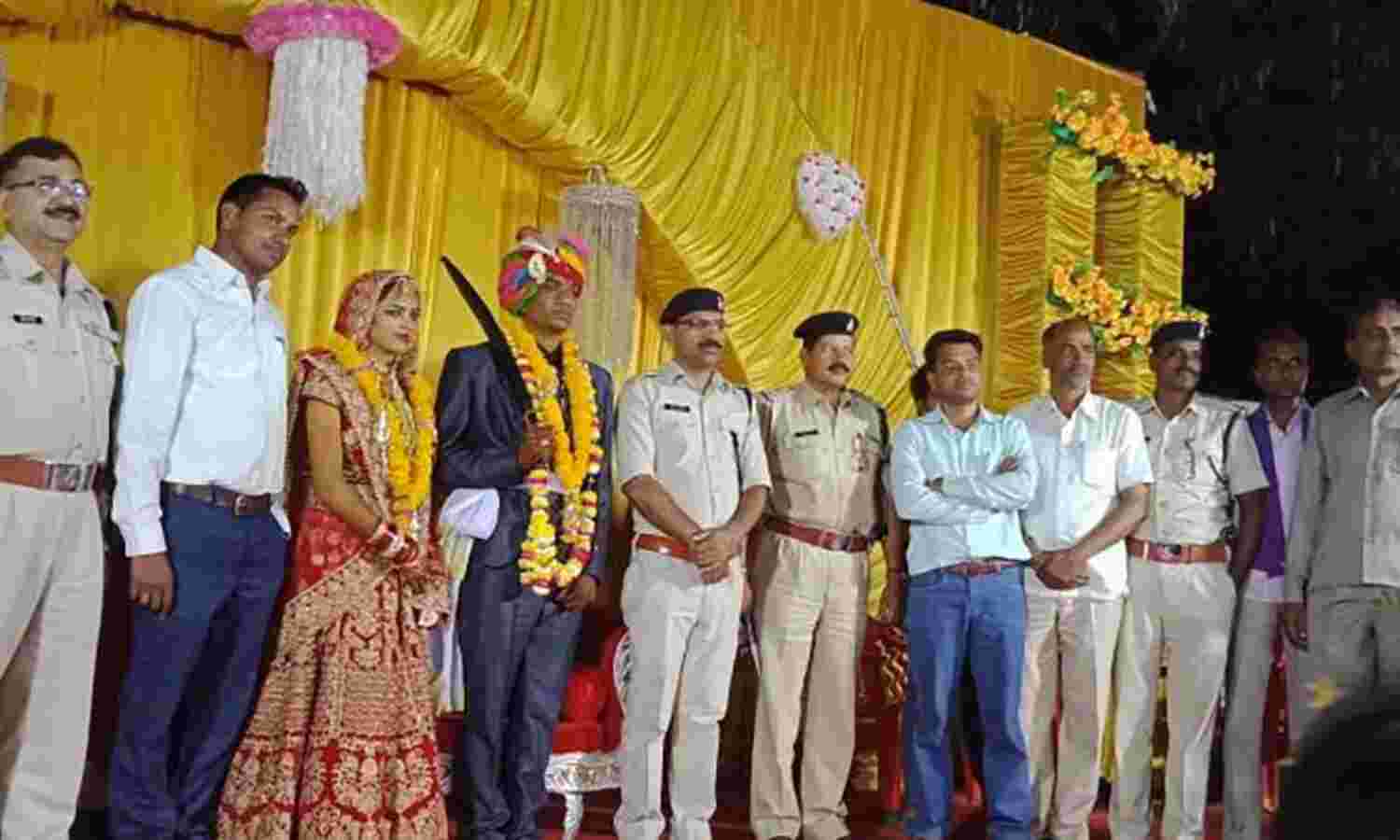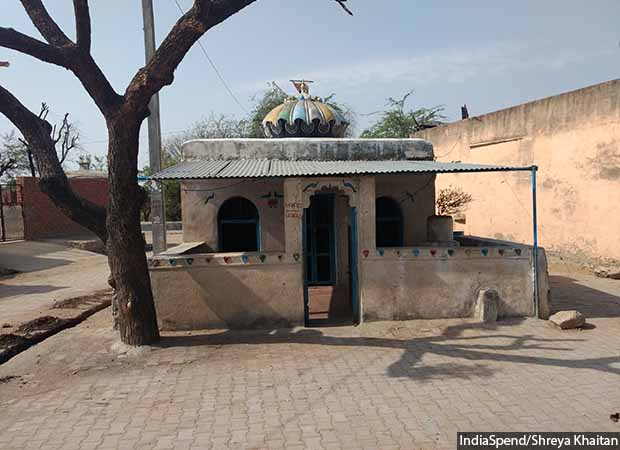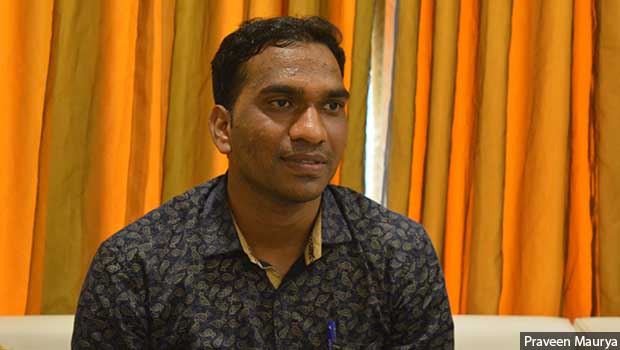Dalit Bridegrooms On Horses Challenge India’s Caste Status Quo

In Madhya Pradesh, when the wedding of Dalit groom Ramprasad Bamnia (center, with sword in hand), was obstructed by people from the upper castes for riding a mare, the Ujjain police came to his rescue and stayed through the wedding.
Ujjain district, Madhya Pradesh, and Bhilwara district, Rajasthan: As a wedding procession of 200-odd people danced to the hit Bollywood song Ghoomar, Ramprasad Bamnia, 27, dapper in a dark blue suit, a multi-coloured turban, and sword in hand, sat proudly atop a white-coloured mare.
“This was the third most important day of my life,” Bamnia said. The happiest was when he started studying at a special boarding school for children from the scheduled castes (SC)--the constitutional name for those who were considered at the bottom of the social hierarchy in India--and the second happiest when he was selected in Madhya Pradesh’s (MP) police force, after several failed attempts.
As the procession made its way to the house of the bride Sonia Bamnia, in Ghatiya village, 20 km north of the religious city of Ujjain, in the central Indian state of MP, Bamnia and his guests were accosted by about a dozen people between the ages of 20 and 28 years. They threatened to burn the music system if the procession didn’t stop playing the song Ghoomar--a traditional Rajasthani folk song adapted for the movie Padmavat, which the Karni Sena, a Rajput fringe group protested alleging that it defamed the Rajput queen Padmavati. The crowd also insisted that Bamnia get off the mare as he crossed the houses of Rajputs, considered to be a higher caste in the traditional system. Bamnia refused to get off the mare.
Over the last couple of years, Dalit weddings have been interrupted by upper castes in Rajasthan, Uttar Pradesh and Gujarat.
In April 2018, in Uttar Pradesh (UP), a Dalit, Sanjay Jatav, was denied the right to ride a mare to his wedding. When he protested, water and electricity supply to his and his fiancé’s family were stopped by some upper caste families.
In 2018, a 21-year-old Dalit, Pradip Rathod, was allegedly killed in Gujarat, by upper caste men, for owning and riding a horse. The Dalit community in Gujarat has also been assaulted for sporting a moustache and performing Garba--a Gujarati folk dance.
Such stand-offs are a manifestation of a deeper struggle within society: Men and women from upper castes are increasingly anxious that Dalits--who make up 16.3% of India’s population--previously considered untouchables, and relegated to jobs considered impure, are enrolling in schools in greater numbers, studying in colleges, finding better jobs and aspiring for long-denied equality.
This is the first part of a two-part series on upper-caste resistance to the rise of Dalits and how the criminal justice system still fails them. The second part explores opposition to inter-caste romantic relationships, and the struggle Dalits face getting justice.
Poverty rates for the SC population have fallen sharply: In urban areas, it fell from 40.6% in 2004-05 to 21.7% in 2011-12, comparable to the fall in poverty rates for the rest of the population, excluding other backward classes (OBCs). In rural areas, poverty rates for SCs fell from 53.5% in 2004-05 to 31.5% in 2011-12, less than the rest of the urban population, excluding OBCs.
Source: Handbook on Social Welfare Statistics (January 2016), Ministry of Social Justice & Empowerment
Dalits question the status quo
Hidden behind these numbers, on the ground, Dalits are questioning the status quo in small ways.
In Dhuwaliya village, in Rajasthan’s Bhilwara district, Prakash Meghwanshi’s wedding procession, or Bindauli, as it is locally called, was stopped by a group of upper caste men and women who asked him to get off the horse in front of the houses of the upper castes, police said. Meghwanshi refused, and when his family threatened to call the police, those stopping the procession let it proceed.
“Since years, no Dalit had ridden a horse at his wedding in our village. People either didn’t even think of doing it or if they did, they would be scared of what the upper caste people would say,” Rampal Balai, the father of the bride in Dhuwaliya, who arranged for the horse, said. “I wanted my daughter to have a big wedding and I was aware of our rights” to mount a horse.
Those who had stopped the procession said it was not caste-related, and that no one rides in front of the temple on a horse. Police said the temple was just a pretext for stopping the procession and that the procession was just passing the side wall of the temple.
“It’s an issue of dignity,” Satish Kumar of the Jaipur-based Centre for Dalit Rights told IndiaSpend. The upper castes feel that if someone considered lower caste can mount a horse, and ride on the main path of a village, “hamari izzat mitti me mil jaayengi (we won’t be respected any longer)”. Dalits, especially those who migrated to urban areas for study and work, want to have the right to ride a horse, just like everyone else does, Kumar said.
“Earlier there was a lot of child marriage in Dalits so such processions were not common. That’s changed now,” said Bhanwar Meghwanshi, who works for Dalit rights in Rajasthan, and is a national council member of the People Union for Civil Liberties.
“This happens because of old attitudes. The upper castes would consider themselves above all, and believe that old traditions would continue forever,” said Panchuram Saraswat, station house officer, who first appeared at the scene of the wedding procession in Dhuwaliya.
“They don’t know about the law.”

The “Charbhuja” temple in Dhuwaliya village, Bhilwara Rajasthan. Upper caste Jats asked a Dalit groom to get off the horse when his wedding procession was passing through a lane to the left of the temple.
In MP, when the upper castes stopped the wedding procession of police constable Ramprasad Bamnia, the guests agreed to stop playing the song Ghoomar, but Bamnia refused to get off the mare or stop the procession. Then, some of the upper castes threw stones--some hit Bamnia’s relatives, one hit Bamnia’s head and he fell off the mare. He was saved because of the turban, he said.
“I never imagined that I would have to go through such trauma at my marriage due to my caste. And there was this unsaid pressure on me because I was a part of the police administration. Had I let it go, what example would others have received,” said Bamnia. “The incident had shaken me and had hurt my self-respect.”
A national human rights commission report lists prohibitions that Dalits have been subjected to such as driving through the locality on their own vehicle, taking a dead body on the main street of the village, especially where upper castes live, mounting a horse at a wedding procession, entering a higher caste locality for wedding functions, and playing musical instruments for their wedding.
“They [upper castes] must think, ‘how can these downtrodden people rise and ride a mare and pretend to be equal to us’,” said Bamnia.
Bamnia went to the local police station to complain, but did not receive much help. He then reached out to the district’s superintendent of police (SP), who promised to send his deputy and 20 members of a special task force to ensure a peaceful wedding. “What really touched me was that seeing me walking back home on foot, ASP (additional SP) sir sent his own vehicle to take me to the wedding,” Bamnia recalled.
“I still think if this could happen to me in a village this close to the city, what atrocities people from my caste must be facing in villages located far-away from the city,” said Bamnia. “We are not competing with anybody; we just want to have decent lives with decent jobs.”
Nationwide, reporting of crimes against SCs has increased. Over the decade to 2016, the reported crime rate against dalits rose by 25%; from 16.3 crimes per 100,000 dalits reported in 2006, to 20.3 crimes in 2016, according to an April 2018 IndiaSpend analysis of 2016 National Crime Records Bureau (NCRB) data, the latest available.
Change in power equations upset upper castes
When IndiaSpend spoke to two of the five men against whom a case had been filed for stopping Meghwanshi’s procession, they said it wasn’t because he was Dalit.
“Nothing happened,” Baluram Jat, 38, said. “We just told them not to break tradition. No one rides a horse in front of the temple. But they wouldn’t stop and we let them go. We did not fight, or verbally abuse them. I don’t know why they filed this case. Just because they are Dalit, they could file a case. It’s the power of being a Dalit.”
Some Jats--a caste higher than the Dalit--from the village said the only problem they have with Dalits is that they relied on reservations to get jobs.
“The problem we have is with the reservation system. Why is it that if one of us (higher castes) gets 80%, we still don’t get a job, and they (lower castes) get a job even if they get 50%,” said a Jat--requesting anonymity--in Dhuwaliya.
Some days after a first information report (FIR) was filed with the local police station at Raila, those accused came to the father of the bride, who had filed the case. “They came and apologised and told me they would not stop any wedding procession in the future,” Balai said. “Ours is a small village and we want to live in peace,” said Ghasiram Jat, 45, one of those named in the FIR for stopping the procession.
Dhuwaliya is a village of about 50-60 households, villagers said, equally divided between upper castes and Dalits. Though both communities have separate temples and don’t communicate much with one another, they do attend each others’ weddings and even give money to the family at such functions. Ghasiram went to the wedding of Balai’s daughter, after the procession was stopped, he said.
Laws and political advancement empower Dalits
In 2015, the Centre for Dalit Rights filed a public interest litigation in the Jaipur High Court listing several cases where Dalits were not allowed to ride a horse through the village during wedding processions, or where funeral processions were stopped.
The Jaipur High Court ruled it was the duty of the district magistrate, the sub-divisional magistrate, superintendent of police, and circle officer of the police to prevent such cases. The court also asked for the formation of a special team in ‘atrocity-prone areas’ to see that funeral rights to Dalits are not denied and their marriage processions are not blocked.
In 2015, an amendment to the national law for prevention of atrocities against SCs and scheduled tribes also made it a punishable offence to obstruct or prevent a person from a SC or tribe from mounting or riding bicycles or motorcycles, or wearing footwear or new clothes in public places, and taking out wedding processions or mounting a horse, or any other vehicle, during wedding processions.
Social scientists believe that seeds of these issues also lie in the rise of social and political upliftment of Dalits in the last few decades.
With economic liberalisation in the 1990s, India saw democratic decentralisation, said Ujjain-based Yatindra Singh Sisodia, professor and director at the Madhya Pradesh Institute of Social Science Research.
With a 1992 constitutional amendment, gram panchayats (village councils) were provided constitutional status, with seats reserved for those from the SCs and scheduled tribes. “This led to the massive increase in participation of Dalits in decision-making processes, which in turn led to the social and economic betterment of the Dalits. The upper castes could not accept this change,” Sisodia told IndiaSpend.
“In the last six 5-year-terms of the panchayats, the system has created a strong panchayat-level representation of Dalits, which challenges the upper castes in important decisions, thus creating friction,” said Sisodia.

Ramprasad Bamnia, a Dalit groom from MP, who was attacked by people from the upper castes for riding a mare and playing the song Ghoomar. His education, and his mother’s political post helped changed the perception of the village towards them, he said.
In Madhya Pradesh’s last gram panchayat elections, which took place in 2014-15, sarpanch (village head) candidates from the SC, Scheduled Tribes and Other Backward Classes won over 18,183 seats, more than 80% of the total 22,604 seats. Only 15,136 seats--about 67% of the total seats--were reserved for candidates of these communities.
“We were always poor. No one cared about us. But then in 2005 my mother won the panchayat elections to become the sarpanch of the village,” said Bamnia. But since Bamnia’s mother had beaten a candidate supported by the upper castes, her office had no support from them. “Gradually, my mother and father made political relations and figured out the ways to carry out works in the panchayat,” Bamnia said.
Around the same time, Bamnia’s elder brother was selected to become a teacher in a government middle school. Bamnia was one of the few in his village to complete high school, he said. “All these changes in my family changed the perception of the entire village. Upper castes of my village never openly said anything against us but they never liked us either,” said Bamnia.
Over a decade to 2011, the literacy rate of India’s SCs grew faster than that of the general population; for SCs, it grew 11.4 percentage points from 54.7% to 66.1%, compared to an increase of 8.2 percentage points from 64.8% to 73% for India’s general population. The gross primary school enrollment rate (the proportion of primary school-aged children who enroll in school) for people from the SCs has consistently been high.
Though a lower proportion of the SC population enrolls in college, the pace of growth in enrollment has been the same as the rest of the population. The gross enrolment ratio (proportion of youth aged 18-23 years who enrolled in higher education) of people from the SCs grew from 13.5% in 2010-11 to 19.9% in 2015-16 versus an increase from 19.4% to 24.5% for the rest of the population.
Source: District Information System for Education 2010-11 and 2015-16; All India Survey of Higher Education 2010-11 and 2015-16; Selected Educational Statistics (2004-05), Ministry of Human Resource Development
Note: Gross enrollment ratio: those enrolled in school as a proportion of children of school-going age in the population
In several villages, changes in caste relationships began years ago. For instance, in Kawaliyans, a village about 5 km from Dhuwaliya, where Balai’s son-in-law, Prakash Meghwanshi, comes from, Dalit grooms have been riding horses in wedding processions around the village for several years. Meghwanshi was surprised when people from his wife’s village stopped the wedding. “I had gone on a horse for my Bindauli in my village just the day before and there were no problems,” he said.
This tussle between upper and lower castes is likely to continue with rising aspirations of the youth, political changes, and the narrowing gap between education levels of different caste groups.
Fifty-four-year-old Bhuraram Parmar’s family represents an upwardly mobile lower caste family. His father moved from their village in Rajasthan and got a job as a government employee in Gujarat. Bhuraram’s younger son studied engineering from a private college in Jaipur and is studying for the government services exam, his daughter is the sarpanch in a Rajasthan village, his daughter-in-law, Vimla, is currently completing an arts degree from a private college in Gandhidham.
In 2014, Bhuraram’s 24-year-old disabled son was pulled off the horse during his wedding in Rajasthan’s Pali district. The case is ongoing in the Pali district court, Bhuraram said. “Most lawyers are unwilling to fight a case against the higher castes, and witnesses scared of the repercussions,” he told IndiaSpend over the phone. “What crime did I commit because my son mounted a horse? I never thought this would happen to me in my own village.”
Still, Parmar is adamant. “When my younger son marries, it will be in the village. He will sit on a horse and go through the village. Even if one of us dies, I will not have any regrets,” he said.
(Tish Sanghera, a graduate of King’s College London and an intern with IndiaSpend, contributed to this story.)
This is the first of a two-part series.
Next: A Dalit Family’s Struggle Shows How India's Justice System Is Failing Its Lowest Castes
(Tripathi is a principal correspondent and Khaitan is a writer/editor with IndiaSpend.)
We welcome feedback. Please write to respond@indiaspend.org. We reserve the right to edit responses for language and grammar.


